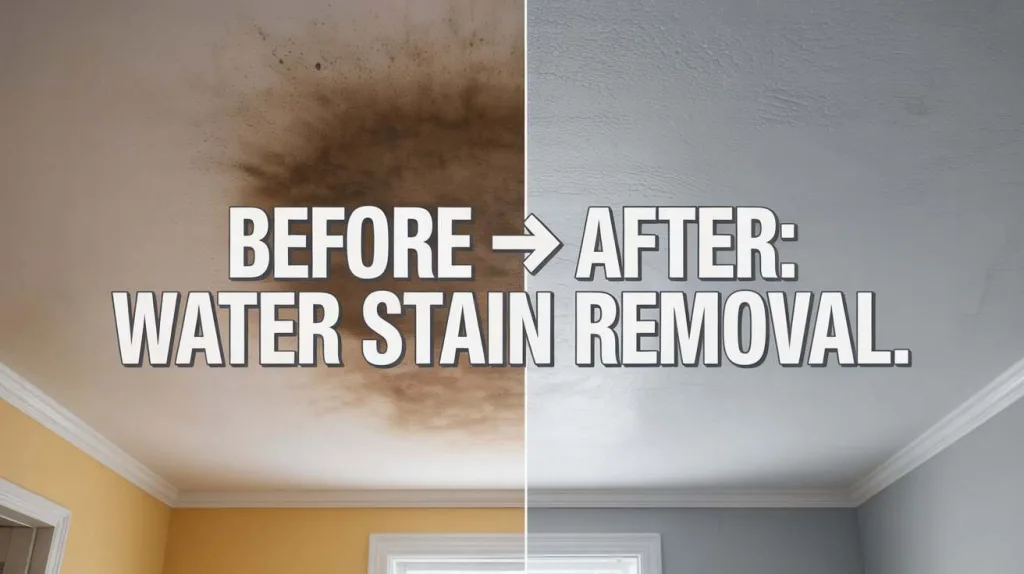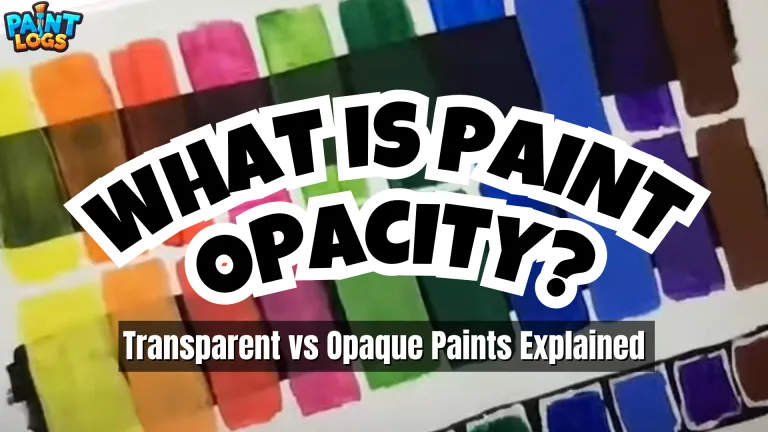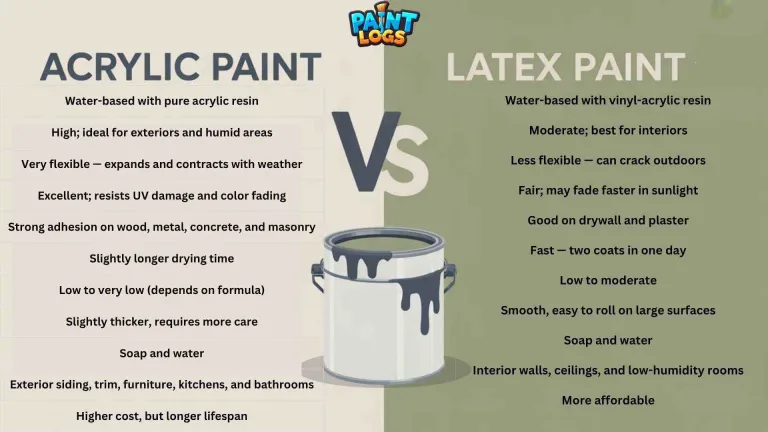Nothing ruins a perfectly painted room faster than a water stain on the ceiling. That brown or yellow patch doesn’t just look ugly, it often means there’s been a leak, condensation, or moisture problem that needs attention. Before you grab a paintbrush, it’s important to fix the source and choose the right method to remove water stains from your ceiling.
To remove ceiling water stains, start with a vinegar and water mix for light discoloration. For brown or stubborn marks, use a diluted bleach solution or hydrogen peroxide. If stains persist, apply a shellac-based primer and repaint. Always fix the leak or condensation source first.
In this complete guide, you’ll learn how to clean, prime, and repaint stains safely using professional techniques and proven DIY methods. Whether you’re dealing with a small brown water stain in your bathroom or a large patch after a roof leak, the process is simpler than you think—if you follow each step carefully.
This isn’t about quick cover-ups. It’s about restoring your ceiling so the stain doesn’t return in a few weeks. By the end, you’ll know when to use vinegar, when to try a bleach mix, and when to seal and paint over the ceiling stain for a flawless finish.

Why Ceiling Water Stains Happen (and Why You Shouldn’t Ignore Them)
Before cleaning or painting, you need to understand what causes a water stain on ceiling surfaces. Most stains happen because water or condensation seeps through layers of paint and drywall, carrying dirt, rust, or mineral deposits to the surface. Once that moisture dries, it leaves behind a visible mark, usually brown, yellow, or gray.
Here are the most common causes:
1. Roof Leaks or Damaged Flashing
A small hole in your roof or cracked flashing can let rainwater drip inside. The moisture travels along beams before showing up as a circular water stain on your ceiling. If you notice new stains after heavy rain, always inspect your roof first.
If the discoloration starts directly beneath attic beams or roof joints, it may be a water stain from roof leakage. Always repair the roof first and allow the area to dry completely before trying to remove a water stain from roof-related damage inside your ceiling.
Proper roof maintenance and drainage are key to preventing ceiling water stains. Federal safety resources such as Ready.gov emphasize regular inspections after storms to reduce long-term water damage.
2. Plumbing Leaks
Leaky pipes, clogged drains, or old fixtures above ceilings—especially in bathrooms—often lead to dark, irregular water stains on ceilings. Even a slow drip can cause discoloration over time.
3. Condensation and Humidity
In humid climates, moisture collects on cooler ceiling areas, forming condensation stains on ceiling surfaces. You’ll see this most often near air vents or in bathrooms with poor ventilation.
Using the right bathroom painting and moisture control methods can prevent this recurring problem and keep paint finishes durable in damp conditions.
4. Mold or Mildew Growth
If the stain looks dark or fuzzy, it could be mold. This usually happens when moisture is trapped inside drywall or insulation. Clean the area thoroughly and make sure it’s completely dry before painting.
Ignoring these signs doesn’t just affect appearance, it can damage your ceiling structure. Drywall stains can spread, paint may peel, and in severe cases, you may face sagging panels or soft spots.
Before cleaning, ensure your space is well-ventilated — prolonged exposure to cleaning agents or paint fumes can pose health risks if the area isn’t properly aired out.
Pro Tip:
Always fix the moisture source first. Cleaning or painting without stopping the leak will only hide the problem temporarily.
If you’re unsure what’s causing the discoloration, use a moisture meter or contact a professional. A quick inspection can save you from repeated ceiling water stain repairs later on.

Prepare Your Ceiling for Stain Removal
The cleaning process for a water stain on ceiling works best when the surface is properly prepped. Paint and primer adhere better to a clean, dry surface — and preparation ensures the stain won’t bleed through again.
1. Gather Your Cleaning Supplies
Here’s what you’ll need for most ceiling water stain jobs:
- White vinegar and water (for mild stains)
- Bleach solution (1 part bleach to 4 parts water for tougher marks)
- Hydrogen peroxide (for odor-free cleaning)
- Sponge or soft cloth
- Spray bottle
- Drop cloths or plastic sheeting
- Ladder
- Protective gloves and goggles
If you plan to repaint afterward, grab a stain-blocking primer (like Zinsser BIN or Kilz Upshot) and matching ceiling paint.
2. Protect the Room
Cover furniture, walls, and flooring with a drop cloth or old sheets. Bleach and primer can drip or splatter. Open windows for airflow to reduce fumes.
3. Clean the Ceiling Surface
Dust or cobwebs can prevent the cleaning solution from penetrating evenly. Lightly wipe the drywall ceiling or plaster area with a damp cloth before applying any mixture.
4. Test Your Cleaning Solution
Before spraying directly on the stain, test a small patch to ensure it doesn’t damage paint or texture especially if you have a popcorn ceiling.
5. Address Textured or Popcorn Ceilings
Textured ceilings need extra care. This same gentle dabbing method works for popcorn and stipple ceilings, where scrubbing can flatten or tear the raised texture. Always use a roller pad or sponge instead of a cloth to safely remove water stains from stipple or popcorn ceilings.
A product like Kilz Upshot spray primer is great for hard-to-reach stains on popcorn textures.
Once your ceiling is prepped and the source of the water problem fixed, you’re ready to apply the right method to remove water stains from the ceiling , whether it’s vinegar, bleach, or a full repaint.
Choose the Right Cleaning Method for Your Ceiling Water Stain
When it comes to the method to remove water stain from ceiling, one size doesn’t fit all. The right technique depends on how deep the discoloration is, what caused it, and what type of ceiling you’re working with — drywall, plaster, or textured.
Most homeowners can start with gentle cleaning options like vinegar or bleach, while tougher brown water stains on ceiling may need sealing and repainting. Below are four proven ceiling water stain removal methods ranked by strength — from light cleaning to full coverage.

Method 1 — Vinegar and Water Solution (Eco-Friendly & Odor-Safe)
If your water stain on ceiling looks light or yellowish, start with this natural cleaner. White vinegar is acidic enough to dissolve mineral deposits without damaging paint or leaving harsh fumes.
How to Use:
- Mix equal parts white vinegar and warm water in a spray bottle.
- Spray the solution directly on the ceiling water stain until damp but not soaked.
- Let it sit for 10–15 minutes.
- Gently blot with a clean sponge or cloth.
- Allow the area to dry completely.
For light stains, you might not need to repaint. If the mark remains faint, apply another round the next day.
This method helps neutralize mild discoloration, kills surface mildew, and removes residue left by evaporated moisture.
Tip: Use distilled vinegar for the best results and better odor control in enclosed rooms like bathrooms or laundry areas.
Method 2 — Bleach Solution (Strong Cleaning Power for Brown Stains)
For older or darker water stains on ceilings, especially brown ones caused by leaks or rust, bleach is the stronger alternative. It lightens the stain and sanitizes the surface at the same time.
Steps:
- Mix 1 part bleach with 4 parts water in a spray bottle.
- Test a small hidden section first to ensure it won’t discolor the paint.
- Lightly mist the stained area and let it sit for 10–15 minutes.
- Blot dry with a clean cloth — do not rub, as that can damage textured surfaces.
- Repeat once if the stain hasn’t lifted fully.
Safety first:
- Wear gloves and goggles to avoid irritation.
- Ventilate the room by opening windows or using fans.
- Cover flooring and furniture with a drop cloth.
Homeowners on forums like Houzz and Reddit confirm this approach works for small to medium stains — but note that it can sometimes lighten paint unevenly. If that happens, follow up with a primer and paint touch-up to even the finish.
Method 3 — Hydrogen Peroxide (Odor-Free Alternative)
If you don’t want bleach fumes, try hydrogen peroxide instead. It works well for mild to moderate discoloration and doesn’t leave residue.
How to Apply:
- Use standard 3% hydrogen peroxide from your local pharmacy.
- Pour into a spray bottle and apply directly to the stain.
- Let it sit for 30 minutes.
- Wipe gently with a clean sponge.
Why it works: Hydrogen peroxide breaks down organic compounds that cause yellowing, making it a great option for bathrooms and kitchens. It’s also safe for most paint finishes.
Expert tip: Use a dehumidifier afterward — peroxide removes the mark, but controlling moisture prevents it from coming back.
Method 4 — Stain-Blocking Primer and Paint (For Deep or Persistent Stains)
If your water stain on ceiling doesn’t fade after cleaning — or if it’s caused by an old leak — you’ll need to seal and repaint. This is the most reliable method to remove water stains from ceiling permanently.
Follow these steps:
- Dry the area completely. Use fans or allow 24–48 hours of natural drying time.
- Apply a stain-blocking primer.
- Shellac-based primers like Zinsser BIN or Kilz Upshot work best.
- For textured ceilings, choose the spray-nozzle version for even coverage.
- Let the primer cure as recommended (usually 30–60 minutes).
- Repaint using moisture-resistant flat ceiling paint to match your existing color.
This approach hides the stain and prevents it from bleeding back through the paint. The primer acts as a moisture barrier, ensuring long-term protection.
Users on Home Improvement forums have praised Kilz Upshot, a ceiling spray primer designed for vertical surfaces, for delivering seamless blending without repainting the entire ceiling.
Also, the professional painters recommend using two thin coats rather than one heavy coat to avoid drips and ensure even coverage.
When to Stop Cleaning and Start Painting
If you’ve tried vinegar and bleach multiple times and the brown water stain on ceiling still reappears, it means moisture penetrated deep into the drywall. At that stage, sealing with a primer and repainting is the only solution.
For recurring stains even after repainting, check for leaks again or consider replacing that section of drywall to prevent mold.
Prime and Repaint for a Like-New Ceiling Finish
If cleaning alone doesn’t erase your water stain on ceiling, sealing and repainting is the most reliable method to remove water stain from ceiling permanently. A stain-blocking primer prevents the discoloration from bleeding through and restores a smooth, even finish.
1. Dry the Surface Thoroughly
Never prime or paint while the surface is damp. Moisture trapped inside the drywall ceiling can cause blistering, peeling, or mildew later. Use fans, dehumidifiers, or cross-ventilation to ensure complete dryness.
Learn how to dry surfaces and spackle faster to ensure your primer adheres perfectly and cures evenly before repainting.
2. Apply a Stain-Blocking Primer
Use a shellac- or oil-based primer such as Zinsser BIN or Kilz Upshot. These formulas seal in brown water stains on ceiling and create a moisture-resistant barrier.
- For textured or popcorn ceilings, choose the aerosol version for even coverage without rolling off texture.
- Apply one light coat first, let it dry, then follow with a second thin coat if the stain shadow remains.
Pro Tip: Hold the spray can 12 inches from the surface to prevent drips and maintain even color blending.
3. Repaint With Ceiling Paint That Resists Moisture
Once the primer cures, use high-quality, flat ceiling paint or a mildew-resistant latex formulated for kitchens and bathrooms. Two thin coats look better than one thick coat and minimize roller marks.
For best color match, feather the edges beyond the primed area or paint the entire panel to avoid subtle differences in sheen.
If you’re working on a white ceiling, apply bright-white ceiling paint and blend outward to keep tone consistent while you remove water stain from white ceiling sections. For older plaster ceilings, make sure the surface is completely dry before priming; shellac-based sealers prevent moisture from bleeding back through.
Step 5 — Prevent Ceiling Water Stains From Coming Back
Repairing a stain means little if the underlying conditions return. Here’s how to keep your ceiling spotless year-round.
1. Fix Leaks Fast
Inspect your roof, attic, and plumbing regularly—especially after storms. A small leak can quickly cause a large ceiling water stain if ignored.
2. Improve Ventilation
Install or clean exhaust fans in bathrooms and kitchens to reduce condensation stains on ceiling surfaces. Keep vents free from dust so moist air escapes efficiently.
3. Control Indoor Humidity
Maintain indoor humidity between 40–50%. Use dehumidifiers or run air-conditioning during humid months. Too much moisture leads to mildew, peeling paint, and recurring drywall stains.
4. Insulate to Prevent Condensation
Poor attic insulation allows warm air to condense on cool drywall. Proper insulation and vapor barriers prevent moisture accumulation that causes yellow or brown spots.
5. Use Moisture-Resistant Products
When repainting, choose paints labeled “bathroom” or “kitchen.” They include mildewcides and flexible binders that tolerate high humidity.
6. Schedule Regular Inspections
Have a professional painter or roofer inspect annually for subtle signs of water damage. Early detection keeps your ceiling looking new and saves costly repairs.
Similar care applies to outdoor materials — our pressure-treated wood painting guide shows how using moisture-resistant coatings extends paint life in humid conditions.
After cleaning a ceiling water stain, seal it with a stain-blocking primer, repaint using mildew-resistant paint, and control indoor humidity to prevent future stains.

When to Call a Professional for Ceiling Water Stains
Some ceiling water stains can be handled with vinegar, bleach, or primer—but if stains return or the drywall feels soft, it’s time to bring in experts.
1. Persistent Stains or Peeling Paint
If you’ve followed every method to remove water stain from ceiling and the mark keeps reappearing, hidden moisture or insulation failure may be the issue. A professional can use infrared scanners and moisture meters to locate the problem fast.
2. Sagging Drywall or Structural Damage
Soft, bubbling, or warped ceiling panels indicate internal water saturation. Professionals can safely remove and replace damaged drywall sections, install vapor barriers, and repaint to code.
3. Mold and Health Concerns
If you smell mildew or see dark patches spreading, don’t attempt to bleach repeatedly. Certified remediation teams treat the source safely and ensure proper air quality testing.
4. High Ceilings and Popcorn Textures
Applying primer evenly on textured ceilings or high cathedral surfaces is risky without the right sprayers and scaffolding. Experienced painters can match texture, color, and sheen seamlessly.
Pro Tip: Hiring a licensed painter or restorer isn’t just about convenience—it ensures lasting results and prevents costly re-repairs later.
Conclusion
Fixing a water stain on ceiling isn’t complicated when you know the process:
- Find and fix the source (leak or humidity).
- Clean the stain with vinegar or bleach solution.
- Let it dry fully.
- Seal with a stain-blocking primer.
- Repaint using mildew-resistant paint.
This step-by-step method to remove water stain from ceiling keeps your home healthy and bright while preventing future discoloration.
If you’d rather skip the ladder and chemicals, Paintlogs’ local painting experts can inspect, prime, and repaint your ceiling—guaranteed to look new again.
Always follow paint fumes safety and ventilation guidelines when cleaning or repainting to maintain healthy indoor air during ceiling restoration.
FAQs
How do I get rid of brown water stains on my ceiling?
Start with a vinegar or diluted bleach solution for light stains. For darker brown marks, allow the surface to dry fully, then apply a shellac-based primer like Zinsser BIN or Kilz Upshot. Repaint afterward to permanently cover the discoloration.
Will Magic Eraser remove water stains on ceiling?
Not effectively. Magic Erasers can remove surface dirt, but they’re mildly abrasive and can damage ceiling paint or texture. Use gentler methods—vinegar, bleach, or hydrogen peroxide—for safe stain removal.
Can you just paint over water stains on a ceiling?
Only if you’ve fixed the leak or moisture problem first. Painting without priming allows stains to bleed through again. Always apply a stain-blocking primer before painting for a lasting result.
Is a water stain on a ceiling serious?
Yes. Even a small stain can signal a roof or plumbing leak, trapped condensation, or early mold growth. Ignoring it may lead to drywall damage, peeling paint, or structural issues.
How do you remove water stains from ceiling tiles?
Ceiling tiles absorb water quickly, so replacement is often best. For light stains, lightly mist a 1:5 bleach-to-water mix and blot gently. Avoid soaking or scrubbing to prevent warping or sagging.
How do you remove water stains from plaster or stipple ceilings?
Use a mild vinegar solution and dab with a roller pad or sponge—never scrub textured surfaces. Once dry, seal the area with a stain-blocking primer before repainting.
How do you remove brown water stains from drywall ceilings?
Mix bleach or hydrogen peroxide with water, spray lightly, and let sit for 10–15 minutes. When dry, apply a shellac-based primer to block the discoloration and repaint to match.
Will a water stain on my ceiling come back after I clean it?
Yes, if the leak or humidity problem isn’t fixed first. Always repair the source before cleaning or repainting to prevent the stain from returning.
How can I stop water stains from showing up again?
Keep indoor humidity between 40–50%, clean exhaust fans, and check your roof regularly. Proper insulation and ventilation help prevent condensation stains on ceiling surfaces.
Do I really need to use a primer before painting over a water stain?
Absolutely. A quality primer seals in the stain so it doesn’t bleed through fresh paint. Oil- and shellac-based primers such as Zinsser BIN or Kilz Upshot work best.
Can I remove a water stain without painting?
Yes, for light yellow marks. Try vinegar or hydrogen peroxide first. If the stain remains or darkens, prime and repaint for a permanent solution.
What if there’s a stain but no leak?
It’s often caused by condensation. Improve ventilation, run a dehumidifier, and insulate your attic to reduce moisture buildup.
How do I remove water stains from popcorn ceilings?
Use a spray bottle with diluted bleach or vinegar. Gently dab with a sponge instead of wiping to avoid flattening the texture. Finish with a spray primer for even blending.
How do I remove a water stain from a white ceiling?
Use bright-white ceiling paint and feather it outward for smooth blending. Cleaning first with vinegar or hydrogen peroxide helps prevent color bleed-through.
What’s the best method to remove water stains from a roof leak?
Fix the roof leak first and let the area dry completely. Clean the ceiling using a bleach or vinegar mix, prime with a shellac-based sealer, and repaint for a uniform finish.






